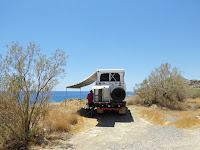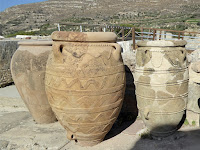Mon 11 Jul 2016. Agia
Galini to Knossos, Herakklion and vehicle ferry
Continued along the southern border in furious winds, passing fields of irrigated horticulture. Drove through tiny towns on a busy Monday morning, “slowly slowly” (just as well, seeing we came up suddenly on fellows working on boat, whilst on its trailer, attached to its car, all protruding into the street!) Gangales had narrow windy streets, men in taverns and cafes, women presumably working at home or in the fields.


Country became drier, more arid mountains, hot blustery winds, heat escalating fast. Detoured via Charakas to look at their great rock/haraki, with its ruins of temple and castle.
Stopped at Viannos memorial to 500 people from 20 surrounding villages, all massacred over two days in 1943 by Nazis in WWII in reprisals against the Resistance. Burnings of villages and looting and destruction of harvests were also carried out on the orders of "the Butcher of Crete".




Called into Myrtos Beach but it was in an airless dry valley so moved further down coast to catch a breeze whilst preparing lunch, a yummy avocado and sweet tomato sandwich.




Completed our loop of southern coast, turning inland/north at Ierapetra.

Took very brief look at the deserted Gortyn ruins, the site of a Minoan palace complex (we heard later this is being considered as a site for the Minoan labyrinth of legend). It appeared the basilica was being restored.


Pulled in to Herakklion mid-afternoon. We'd been looking forward to seeing the ruins at Knossos, GirlRob reading aloud in the car the myths about King Minos and his son the Minotaur, half man/half bull, who roamed the labyrinth, as well as the story of the lovers Theseus and Ariadne who saved potential sacrificial victims. Knossos is indeed intricate, a sprawling complex of 20,000 square metres, based around a central courtyard and branching out into four wings, housing more than a thousand interlinking chambers – from royal quarters to a throne room, banquet halls, workshops, storerooms, shrines, wine presses, grain mills and repositories.





However, we were quite disappointed when we got to the palace and surrounding rooms. Apparently English archaeologist and academician Arthur Evans who'd purchased the site believed the splendour of Knossos could be revived if sections of the palace were substantially reconstructed. We discovered that controversy surrounds his over-use of wooden beams, squat reinforced concrete pillars, and recreations of paintings and frescoes (apparently all based on fragmentary evidence).
Personally we found the "restoration" overpowering – hard to find the genuineness of the original archaeology. "Reconstructed" wall paintings were over-bright, amateurish and simplistic, obscuring what might have been the fine style of the originals. We grudgingly admitted our visit was worth neither the time nor the money.
Continued along the southern border in furious winds, passing fields of irrigated horticulture. Drove through tiny towns on a busy Monday morning, “slowly slowly” (just as well, seeing we came up suddenly on fellows working on boat, whilst on its trailer, attached to its car, all protruding into the street!) Gangales had narrow windy streets, men in taverns and cafes, women presumably working at home or in the fields.


Country became drier, more arid mountains, hot blustery winds, heat escalating fast. Detoured via Charakas to look at their great rock/haraki, with its ruins of temple and castle.
Stopped at Viannos memorial to 500 people from 20 surrounding villages, all massacred over two days in 1943 by Nazis in WWII in reprisals against the Resistance. Burnings of villages and looting and destruction of harvests were also carried out on the orders of "the Butcher of Crete".




Called into Myrtos Beach but it was in an airless dry valley so moved further down coast to catch a breeze whilst preparing lunch, a yummy avocado and sweet tomato sandwich.




Completed our loop of southern coast, turning inland/north at Ierapetra.

 |
| Obviously mercenaries are not Holy.... |
Took very brief look at the deserted Gortyn ruins, the site of a Minoan palace complex (we heard later this is being considered as a site for the Minoan labyrinth of legend). It appeared the basilica was being restored.


Pulled in to Herakklion mid-afternoon. We'd been looking forward to seeing the ruins at Knossos, GirlRob reading aloud in the car the myths about King Minos and his son the Minotaur, half man/half bull, who roamed the labyrinth, as well as the story of the lovers Theseus and Ariadne who saved potential sacrificial victims. Knossos is indeed intricate, a sprawling complex of 20,000 square metres, based around a central courtyard and branching out into four wings, housing more than a thousand interlinking chambers – from royal quarters to a throne room, banquet halls, workshops, storerooms, shrines, wine presses, grain mills and repositories.





However, we were quite disappointed when we got to the palace and surrounding rooms. Apparently English archaeologist and academician Arthur Evans who'd purchased the site believed the splendour of Knossos could be revived if sections of the palace were substantially reconstructed. We discovered that controversy surrounds his over-use of wooden beams, squat reinforced concrete pillars, and recreations of paintings and frescoes (apparently all based on fragmentary evidence).
 |
| The "restored" Throne Room |
Personally we found the "restoration" overpowering – hard to find the genuineness of the original archaeology. "Reconstructed" wall paintings were over-bright, amateurish and simplistic, obscuring what might have been the fine style of the originals. We grudgingly admitted our visit was worth neither the time nor the money.
 |
| We had no way of knowing if an original giant bull-worshipping icon ever existed... |
At the tourist stall outside though, we did find the Sparta (“Never Surrender”) T-shirts we'd been looking for, to take home to all the grandsons, plus BoyRob picked up a Cretan cookbook (whilst shopkeepers who speak English smile at the "joke", GirlRob was uncomfortable that the people of Crete market themselves as Cretans).
Had a quick dinner at a cafe and made it to the wharf in plenty of time to board the ferry, the Blue Horizon, for the return trip to Athens.

 |
| Goodbye Crete - we enjoyed our relaxing interlude |
Not looking forward to our visit to DHL in the morning, communication about the clearance of the parcels has not only been ad hoc and inconsistent, but their treatment has been downright rude. GirlRob is tempted to lodge a complaint (maybe once she has both parcels in hand…)























No comments:
Post a Comment